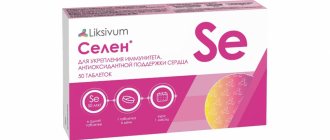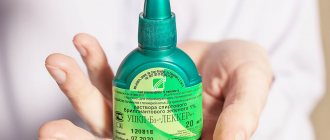Full text of the article:
Surely you have heard about iodine deficiency in the body. This is repeated not only in advertising. Doctors are also sounding the alarm. The Endocrinological Research Center of the Russian Ministry of Health publishes statistics according to which about one and a half million adults and more than half a million children in the country have thyroid diseases and need specialized endocrinological care. The cause of most thyroid diseases is iodine deficiency in the human body.
Causes of iodine deficiency in the body
The body receives vitamins and nutrients mainly through food; the food we are used to eating is not rich in iodine, so there is a risk of developing iodine deficiency. Iodine as such is difficult to detect in nature, but some plants are able to accumulate it, for example, algae, so kelp contains 150 times more iodine than any vegetable grown on earth. Seafood and sea dwellers, who obtain iodine from underwater vegetation, are rich in iodine. Fish or seafood caught in the sea themselves become good suppliers of iodine for humans. The problem is that residents of only some regions of Russia have free access to marine resources, and for them, fish and seafood are not the basis of their daily diet.
People all over the world experience iodine deficiency. Residents of modern Switzerland, for example, have suffered from severe thyroid diseases since the Middle Ages. The situation was slightly improved only at the beginning of the last century, when industry came to the aid of medicine and the production of iodized products began.
Sources of iodine and methods of preventing its deficiency
Iodine belongs to the vital microelements; it is a component of the thyroid hormones: thyroxine (T4) and triiodothyronine (T3), which determine the activity of almost all metabolic processes in the body and are responsible for the formation and development of many functions of the human brain.
According to research from the Research Center of the Russian Academy of Medical Sciences and regional health authorities (1991–2006), the prevalence of endemic goiter in children and adolescents in Central Russia is 15–25%, and in individual regions - 41% (Fig.) [1–4]. At the same time, the actual average iodine consumption by a Russian resident ranges from 40 to 80 mcg per day, which is 3 times (!) less than the recommended norm, and only about 15–30% of the population regularly consumes iodized salt.
| Rice. The structure of thyroid pathology caused by micronutrient deficiency in children and adolescents living in the Russian Federation (according to the Ministry of Health of the Russian Federation, 2002) |
The human body does not synthesize iodine and must receive it in ready-made form. The main natural sources of iodine are products of plant and animal origin. Products fortified with iodine are carriers of high concentrations of iodine, including iodized salt, iodized bread, fermented milk products (KMPr), and adapted milk formulas for children. To eliminate and prevent deficiency of essential micronutrients in children, the inclusion of foods enriched with micronutrients (milk and CMPR) in the diet plays an important role. These products for children should provide 10–30% of the daily nutrient requirements when consuming one serving of the product, taking into account the possible negative effects of their overdose, as well as changes in organoleptic properties [5, 6]. For example, the inclusion in the diet of preschool and school-age children of balanced KMPR “Rastishka”, enriched with important micronutrients - iodine, calcium, vitamin D (Table 1), will contribute to the normal growth and development of the child’s body.
In accordance with WHO recommendations, the basic means for mass prevention of iodine deficiency diseases is iodized salt. However, for groups at increased risk of developing iodine deficiency - children, adolescents, pregnant and nursing mothers - it is necessary to use medications containing iodine.
After the birth of a child, the importance of thyroid hormones in the development of his brain and the formation of cognitive functions does not decrease; on the contrary, thyroid hormones play a very important role in the process of differentiation of neurons, growth of axons and dendrites, in the formation of synapses, gliogenesis, maturation of the hippocampus and cerebellum (throughout the first year of life), and also stimulate myelinogenesis and myelination of neurocyte processes (within 3 years of postnatal development).
The synthesis of a sufficient amount of thyroid hormones and the formation of an iodine depot in the thyroid gland of a newborn is possible only with an intake of 15 mcg of iodine per 1 kg of body weight per day, and in premature infants - 30 mcg per 1 kg. Thus, for a newborn, an adequate level of iodine intake is at least 90 mcg/day. The optimal way for newborns to obtain iodine is breast milk. A nursing woman must receive 200–250 mcg of iodine daily in the form of a medicinal product. This will fully meet the iodine needs of both her child and herself.
The need for iodine per 1 kg of body weight per day decreases significantly with age: in a newborn it is 15 mcg/kg, decreases by almost 2 times by the end of the first year of life, and for an adult this value is at the level of 2–2.5 mcg/kg.
To meet the body's need for iodine, the following daily intake standards are recommended (WHO and the International Council for the Control of Iodine Deficiency Diseases - ISKIDS (Geneva, 2001)): 90 mcg - for children 0–5 years old; 120 mcg - for school-age children (from 6 to 12 years); 50 mcg - for adolescents and adults (12 years and older); 200 mcg - for pregnant and lactating women.
The female body's need for iodine also increases during breastfeeding. WHO, UNICEF and ICIDH recommend that breastfeeding mothers consume 200 μg of iodine per day [7]. However, this amount may not be enough to cover the iodine needs of the mother and child. The content of the element in breast milk under conditions of adequate iodine supply is 150–180 mcg/l, milk production is from 0.5 to 1.1 l per day in the first 6 months of feeding, and the daily loss of iodine with milk from the mother’s body is from 75 up to 200 mcg. Thus, the need for iodine during breastfeeding in women should be from 250 to 350 mcg/day [8].
Based on these premises, a group of WHO experts developed recommendations for optimizing iodine intake levels in pregnant and breastfeeding women and children under 2 years of age. It is recommended to increase the daily iodine intake in pregnant and lactating women to 250 mcg/day. At the same time, the existing standard for iodine consumption by children under 2 years of age has been retained - 90 mcg/day. Along with this, WHO experts for the first time established levels of iodine consumption above which no additional positive effect on the functional state of the thyroid gland should be expected. However, the upper limit of the safe level of iodine intake remains unchanged - 1000 mcg/day [8].
Prevention of iodine deficiency diseases in newborns and infants. According to the US National Academy of Sciences, taking into account the average amount of milk received by a newborn (0.78 L per day), as well as the average iodine concentration in milk in countries with adequate iodine intake (146 μg/L), the average amount of iodine contained in breast milk is 114 mcg/day. In addition, a study of the balance of iodine in children's bodies showed that in a six-month-old infant, urinary iodine excretion is 90 mcg/day.
Based on these data, 90 mcg of iodine per day is recommended for children from 0 to 6 months, and 110–130 mcg/day for children over 6 months.
For breastfed infants, this issue is resolved by correcting the mother’s diet, in which great importance is attached to the regular intake of pharmacological iodine preparations during lactation. Pregnant and lactating women should receive iodine supplements so that the total daily iodine intake is 250 mcg.
A more serious problem is associated with correcting the nutrition of formula-fed infants. For children who do not receive mother's milk from birth or after 3–6 months of life, the only baby food products that can provide them with the necessary amount of iodine are artificial milk formulas enriched with the microelement (human milk substitutes) and cereals based on them.
Currently, all iodine-fortified baby food products on the Russian market are presented by foreign manufacturing companies. The quantitative spread of iodine content in baby food products is extremely wide and ranges from 33 to 170 mcg per liter of finished formula.
In accordance with the latest recommendations approved by WHO and ISICHD, the iodine content in formulas for full-term infants should be 100 micrograms per liter, and for premature infants - 200 micrograms per liter. Thus, only about half of the mixtures meet the requirements of international expert organizations in terms of the amount of iodine.
When choosing a formula, parents need to focus on the balance of its composition in all the main ingredients (proteins, fats, carbohydrates, vitamins, etc.). The iodine content is usually indicated on the packaging of the breast milk substitute (in 100 g of dry formula or in 100 ml of ready-made formula). In order for the daily dose of iodine administered with the mixture to correspond to the preventive one, its content in 100 ml of the finished mixture should be at least 9–10 mcg, and in 100 g of dry iodine - at least 70 mcg [5].
In the second half of life, the need for iodine increases slightly, and the volume of the mixture consumed decreases. In this regard, all children receiving any human milk substitutes in the second half of life need additional iodine in the composition of pharmacological tablets and/or complementary feeding products (porridge, natural products).
If the mother is breastfeeding and iodine prophylaxis is not carried out for any reason, the child needs to take at least 90 mcg of iodine daily from birth (Table 2).
When using a milk replacer with insufficient iodine content (< 9 mcg / 100 ml of ready-made formula), additional iodine is introduced into the child’s diet individually - according to the recommendations of specialists.
Ways to prevent iodine deficiency in children aged 1 to 3 years. The level of iodine content in salt during mass preventive measures corresponds to the needs of an adult receiving from 4 to 10 g of table salt per day. In children, especially under 3 years of age, the need for sodium is lower, and for iodine - slightly less than in adults: it is 90 mcg / day. Therefore, the amount of iodine a child receives from iodized table salt may not be sufficient.
To compensate for the deficiency of this microelement in this age group, along with products enriched with iodine (KMPr, cereals), physiological doses of iodine must be used in the composition of potassium iodide tablets.
Puberty. During puberty, the function of the thyroid gland undergoes certain changes associated with adaptation to the rapid pace of growth and development. At the beginning of puberty, there is an increase in thyroid-stimulating hormone (TSH) levels, followed by an increase in T4 levels. These changes are physiological and are aimed at maintaining a high level of metabolism. The increase in the volume of the thyroid gland during this period is determined not only by the influence of TSH, but also by an increase in the peripheral conversion of T4 to T3, acceleration of iodine excretion, and an increase in the synthesis of thyroxine-binding globulin. In addition, insufficient iodine intake increases the sensitivity of thyrocytes to the stimulating effect of TSH.
In iodine-deficient regions, the process of puberty is often accompanied by the formation of diffuse euthyroid goiter. Among all population groups, endemic goiter occurs most frequently in adolescents, especially girls.
During the period of rapid growth and development, the need for many microelements and vitamins increases. The preferred method of preventing endemic goiter in adolescents is the administration of potassium iodide preparations or multivitamins containing physiological doses of iodine.
Prevention and treatment of iodine deficiency diseases in Russia are of national importance, which explains the complex nature of the necessary measures.
For questions regarding literature, please contact the editor.
E. A. Troshina , Doctor of Medical Sciences, Professor N. M. Platonova , Candidate of Medical Sciences F. M. Abdulkhabirova , Candidate of Medical Sciences A. V. Sekinaeva ERC RAMS, Moscow
Does iodized salt help replenish iodine deficiency in the body?
The most common iodine-containing product for us is iodized salt. You can find it on the shelves of almost all grocery stores. Iodized salt is believed to help combat iodine deficiency. More than a hundred countries are fighting iodine deficiency at the legislative level, developing preventive measures. In Russia, large-scale prevention of iodine deficiency is not yet carried out, so about 70% of the population suffers from it.
In the first stages, replenishing iodine deficiency in the body is not so difficult; diet and taking medications containing potassium iodide help. You can also get some iodine from foods: fish, eggs, white meat and seaweed. 100 grams of seaweed contains two daily requirements of iodine, so with its help you can quickly replenish iodine deficiency in the body. By the way, it is recommended for an adult to take 250 mcg of iodine per day.
How to saturate the body with iodine?
The trace element iodine has been known to people for more than 200 years. During this period it was used as a disinfectant and antibacterial agent. Bottles with bright liquid were widely used by lovers of “folk” remedies for treating bronchitis, coughs, and abscesses. They used an alcohol solution as a topical application in the form of an iodine network. And only in the middle of the last century, scientists discovered a close relationship between iodine deficiency in the human body and various internal pathologies. Which included nodular changes in the thyroid gland, the development of dementia and even a decrease in the level of immunity.
Currently, there is irrefutable evidence, confirmed by practical research, that iodine is one of the most important microelements. On average, the adult human body contains a microscopic amount of this element. It does not exceed 30 mg. With higher levels, poisoning can develop, which leads to very sad consequences. The main part is contained in the tissues of the thyroid gland. This is an important organ of the endocrine system, which consists of small follicular formations filled with fluid. The production of the hormone thyroxine also occurs there. It is for this substance that iodine is required.
The sphere of influence of the hormones produced by the thyroid gland is so large that it is quite difficult to overestimate it. These are protein and fat transformations in the digestive process, regulation of the process of using carbohydrates, responsibility for preserving and maintaining normal body temperature, ensuring mental activity and much more.
With iodine deficiency, irreversible processes begin in the human body, which primarily affect the tissues of the thyroid gland itself. Uncontrolled growth of follicles occurs in order to capture more of this trace element from the blood entering the tissue. Nodular diffuse goiter develops. In children, iodine deficiency leads to insufficient mental development. Such children may lag behind not only mental, but also physical development from their peers. They often suffer from colds, are lethargic, with reduced activity and ability to concentrate.
Symptoms of iodine deficiency
Due to the fact that the thyroid gland affects almost all processes in the body, there are no specific manifestations of iodine deficiency, and it is often represented by a variety of symptoms, combinations of which imitate various diseases.
The following signs should alert you:
- chronic fatigue, fatigue and drowsiness;
- splitting of nails, dry skin, brittleness and hair loss;
- poor resistance to stress, memory impairment, decreased reaction;
- weight gain, swelling, anemia, chilliness, frequent colds;
- disorders of the reproductive system (infertility, impotence in men, menstrual irregularities);
- constipation, cholelithiasis.
Of course, this list cannot be considered complete, because in order to describe the variety of manifestations of iodine deficiency, more than one article will be needed. It should only be emphasized that the most severe and irreversible consequences can be caused by a lack of iodine in the body of children and the fetus, causing delays in physical and mental development.
The main risk factors for the development of iodine deficiency are the effect of ionizing radiation and the low content of this element in food. Also, iodine deficiency can be caused by pregnancy, smoking and taking oral contraceptives.
The first objective change usually noted by a doctor is pathological growth of the thyroid gland. This increase in size, as a rule, is a compensatory mechanism by which this organ tries to “stock up” on the iodine necessary for the production of its hormones. Typically, these changes are diagnosed during a routine preventive examination and require clarification through laboratory and ultrasound examinations.
How to saturate the body with iodine?
Of course, problems associated with insufficient iodine levels can be easily avoided. Moreover, one of the most correct options for preventing a deficiency of this element in the body is to replenish iodine from food.
Thus, it is known that ordinary beets, potatoes and parsley can boast a record amount of iodine. It is logical to assume that a properly formulated diet can solve all problems.
However, as we previously mentioned, the use of mineral fertilizers and herbicides significantly reduces the amount of iodine that can be absorbed from vegetables and fruits. Therefore, the use of the above products in food does not guarantee sufficient prevention of iodine deficiency.
There is a misconception that the simplest and surest method of replenishing iodine deficiency in the body is to use a diluted alcohol solution or Lugol's solution. These remedies, popular among lovers of self-healing, need convincing counter-advertising not because they have lost their relevance or are outdated. They're just usually not used for their intended purpose.
For example, drawing an “iodine grid” at the injection site or repeatedly lubricating the throat with a sore throat, as well as other procedures that seem banal to us, are in fact not so safe, because their effect is based on the absorption of iodine, the amount of which enters the body is impossible control. This is especially important to consider when it comes to young children or people who already have thyroid problems.
The simplest and surest way to compensate for iodine deficiency is to constantly eat iodized table salt and seafood. Harm to the body with this method of prevention is completely excluded, since excess iodine received in this form is easily eliminated from the body.
As for tablet preparations that replenish the lack of iodine in the body, such as potassium iodite and potassium iodate, their use should be agreed with a doctor. Otherwise, troubles cannot be avoided. After all, an increased content of iodine in human tissues and organs can also have dire consequences.
Endocrinologist Elena Vitalievna Gomolko
UZ "22 – I city clinic"
What can iodine deficiency lead to?
Iodine deficiency is especially harmful to pregnant women; iodine plays a key role in the development of the fetus and the cognitive functions of the infant. In the first four months of development, the fetus does not yet have a thyroid gland separate from the mother, so the mother must provide the child with iodine. Iodine deficiency can lead to the development of serious diseases: problems with vision, hearing, paralysis, cretinism and mental disability. True, we are talking about a high degree of iodine deficiency, while residents of Russia are characterized by moderate iodine deficiency, although it is dangerous.
Signs of iodine deficiency in the body
Acute iodine deficiency triggers a chain reaction in the human body. The pituitary gland is the first to fire, it begins to produce a larger volume of thyroid-stimulating hormone (TSH) to stimulate the thyroid gland. The thyroid gland strives to obtain the necessary iodine from the blood in order to produce the hormones T3 and T4; increased work leads to an enlargement of the gland.
Long-term iodine deficiency can lead to hypothyroidism. External signs of hypothyroidism are chills or fever, irregular heartbeat, pressure surges, weight changes, constant feeling of fatigue, bad mood.
Another characteristic sign of severe iodine deficiency is “goiter.” Increased activity of the thyroid gland leads to its noticeable enlargement, outwardly it begins to resemble a bird's goiter, hence the name.
How to compensate for iodine deficiency in the body?
Treatment of iodine deficiency is prescribed by a doctor after a visual examination and tests. A comprehensive examination will help determine the real level of iodine deficiency and select the correct therapy. Self-medication is dangerous. Sudden intake of large amounts of iodine into the body can only aggravate the situation. The thyroid gland will begin to supply the body with too much hormone, which will cause iodine-induced thyrotoxicosis. Doctors treat the thyroid gland using artificial analogues of its hormones. This allows you to slow down the growth of the thyroid gland and gradually normalize its functioning.
DEPARTMENT OF HEALTH OF THE BELGOROD REGION
More and more often we hear that the diet of modern people lacks iodine. Why is this microelement so important for health, and what are the consequences of its absence?
Why is it needed?
Iodine is the only trace element that is directly involved in the synthesis of hormones. It is involved in the production of the thyroid hormone - thyroxine, the creation of which accounts for up to 90 percent of iodine consumed in food.
Thyroxine (and, consequently, iodine) controls and enhances the intensity of metabolism: water-salt metabolism, metabolism of proteins, fats and carbohydrates. It also regulates heat exchange in the body, cell division and growth, the functioning of the liver and cardiovascular system.
In addition, the state of the nervous system, the emotional state of a person and his psychological health depend on this hormone.
If there is not enough iodine
If not enough iodine is supplied with food, the thyroid gland produces little thyroxine. This condition is called hypothyroidism or iodine deficiency.
Most often, the lack of iodine is the first to affect the functioning of the nervous system: a person becomes forgetful, his attention and reaction decrease, irritability and drowsiness appear, and sometimes even depression occurs.
In addition, the immune system weakens, fluid stagnates in the body, women's menstrual cycle is disrupted, and infertility may develop. Problems with the heart and blood vessels appear: arrhythmia, increased blood pressure, decreased hemoglobin levels in the blood.
Body weight also increases - after all, there is too little thyroxine for the process of energy consumption to proceed in a normal way, and it is deposited in the form of fat reserves. If you eat well and exercise a lot, but cannot get rid of really extra pounds, you should consult an endocrinologist - a slow metabolism is sometimes one of the signs of iodine deficiency.
If iodine deficiency is not replenished for a long time, thyroid tissue begins to grow, trying to compensate for the lack of thyroxine production in the number of cells. This enlargement of the thyroid gland is called a goiter.
For whom is iodine deficiency most dangerous?
Iodine deficiency is especially dangerous for pregnant women. If this important microelement is missing, the pregnancy may be terminated prematurely, and the baby may be born dead or with a serious developmental defect - cretinism.
The growing body of children suffers no less from iodine deficiency: they begin to lag behind in mental and physical development. As a rule, this is a slowdown in body growth and impaired perception of information and speech.
How much iodine do you need?
The World Health Organization recommends consuming 120 to 150 mcg of iodine per day every day. Moreover, this amount should come with food. It is easy to check whether there is enough iodine in the body using a urine test, along with which its excess is eliminated.
The “mesh” will not show anything
But the common method of assessing the rate of “absorption” of an iodine mesh applied to the skin is nothing more than a delusion dangerous to health. After all, only iodine salts – iodides – are absorbed in the body. And an iodine solution contains molecular iodine - that is, a completely different form of iodine. And the rate of disappearance of the mesh depends only on body temperature and the external environment.
How to replenish iodine deficiency and boost immunity
What harms the immune system, and what, on the contrary, helps improve it? Read our list of easy recommendations.
The most iodine is found in seafood: in seaweed it is found about 220 mg per 100 g, and in shrimp - 150 mg per 100 g. In meat, milk and dairy products, the iodine content is only 7-16 mcg / 100 g. And in drinking water There is very little of it in water in most regions of our country - 0.2–2 µg/l.
If there is a clear lack of iodine in the diet, an endocrinologist may prescribe special vitamin and mineral preparations containing iodine. You cannot start taking them uncontrolled - the type of drug and its dosage are selected only after detailed tests.
In order to enrich the diet with iodine, specially labeled food products are now produced, to which 10 to 30 percent of the daily requirement of this microelement is added.
The most popular among them is iodized table salt, which contains about 45 mcg/g of iodine. If you use it in food instead of regular food, you can get the entire daily requirement of iodine.
What you need to know about iodized salt?
Information about added iodine should be included on the salt package. For Russia, these are GOSTs 13830–91 and R 51575–2000. “Sea”, “fossil”, “phyto”, “with vitamins” salts do not contain a sufficient amount of iodine.
Iodized salt retains its properties for no longer than 3–4 months, even in a closed container.
Very much iodine evaporates from such salt during intense boiling. With different methods of preparing food, its losses range from 22 to 60 percent.
Iodine also quickly evaporates from wet salt and open salt shakers.
The main thing about iodine
Iodine deficiency prevents us from losing weight and enjoying life, and its deficiency can only be determined by an endocrinologist based on blood and urine tests. The easiest way to compensate for iodine deficiency in the diet is to use only iodized salt in the kitchen.









